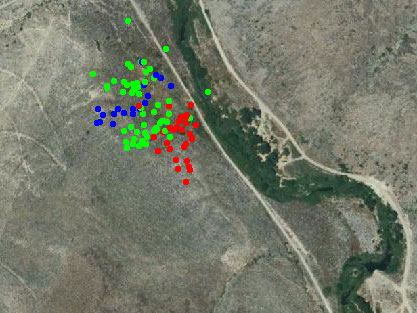|
Scientific Question & Analysis:
How does the geology affect fossorial mammals?

Fossorial Mammals of Waterville
Each of the students created a "wanted poster" of their Waterville Plateau mammal.
Badger
Badgers occur in open habitats in eastern Washington including semi-desert, sagebrush, grassland, meadows, and grassy bald spots on high ridge tops. They can be present in open forest (primarily Ponderosa Pine) with grassy ground cover.

Interest facts:
- Badgers have keen vision, scent, and hearing.
- Badgers are good at digging burrows.
- Badgers help to control rodent populations.
Read more
Pygmy Rabbit
It is small and slate gray with a pinkish tinge in the winter but turns a brownish color in the summer. The tail is nearly hidden. It's ears are small for a rabbit.
The Pygmy Rabbit is typically found in areas of tall, dense sagebrush cover. They are highly dependent on sagebrush to provide both food and shelter throughout the year.
Lives in burrows that are among clumps of tall sagebrush in cooler deserts of the Great Basin.

Interest facts:
- The Pygmy Rabbit is the smallest rabbit in the United States.
- Pygmy Rabbits are dependent upon sagebrush for winter food.
- They are the only rabbits in the United States that dig their own burrows.
Read more
Striped Skunk
The striped skunk is about the size of a house cat, 14 pounds
Color: black and white
Markings: the skunk’s fur and skin is black and white.
They are usually found in brushy
or rock areas. They are also seen at Douglas Creek walking along the side of
the dirt road.
Interest facts:
- The sounds it makes the animal makes: They make squeaks and stomp their
feet.
- Skunks can spray up to 10-12 feet, they can spray up to 8 times.
- They
have really good noses and they like sweets.
- They will eat anything they
can find.
Striped Skunk
Wanted Poster (pdf)
Other Fossorial Mammals of Waterville:
Nuttall's cottontail, Northern Pocket Gopher

Definitions:
Fossorial Mammal = A burrowing mammal having limbs adapted for digging.
Resources:
Northwest Origins - An Introduction to the Geologic History of Washington State
Mammal Fact Sheets - including Washington Fossorial Mammals
6th Grade
Geologist »
Literate about Biodiversity »
| 







